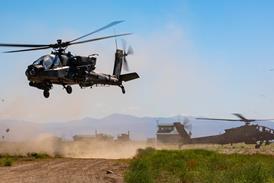The US Army’s deputy chief of staff for program development is betting the service’s future vertical lift platform will be optionally manned, but doesn’t believe the Army should rule out a fully unmanned rotorcraft either.
The Army is leading the FVL effort, a joint programme that includes the US Air Force and Marine Corps, which would create a common helicopter across the US armed forces. Earlier this summer, the Marine Corps’ deputy commandant for aviation vouched for an optionally manned plan for the next generation of medium-lift, long-range rotorcraft.
“Personally, I could easily see unmanned rotary wing aircraft in the future,” Lt Gen Mike Murray said this week. “I think the reality of what will end up with is ‘optionally manned’ given that there is not a consensus on my opinion.”
Although Murray and Marine Corps Lt Gen Jon Davis are not completely aligned on the FVL requirements, the branches have time to arrive at an agreement. The Army will not be able to afford FVL until the service stops funding the Lockheed Martin/Sikorsky UH-60 and Boeing AH-64 Apache, Murray says.
“There’s no money to do it concurrently,” he says.
FVL will include four different classes of helicopters, with class 2 fulfilling the Apache’s attack role and the UH-60’s utility mission. The next-generation aircraft, which would combine the speed of a fixed wing aircraft with a helicopter’s vertical lift capabilities, could be fielded by the 2030s. But the FVL effort would create a diverse family of helicopters with several missions, not just one platform with a few variants. The rotorcraft would recapitalise the Bell OH-58 Kiowa Warrior and Boeing CH-47 Chinook, as well as fulfill a heavy lift mission similar to the Lockheed Martin C-130 transport aircraft. For the Marines, the rotorcraft could offer a cheaper version of the MV-22 Osprey for a medium assault mission.
Mike Hirschberg, executive director of the American Helicopter Society (AHS) International, agreed FVL could be either unmanned or optionally manned, given its diverse mission sets. Hirschberg foresees half a dozen different aircraft for FVL, which could open up contracts to various manufacturers.
“They’re not necessarily going to be related; it’s not like Sikorsky or Bell is going to win everything,” he says. In addition, the Pentagon is “looking to maximise commonality for cockpits and engines.”
Source: FlightGlobal.com























